The Doctor: First Doctor (William Hartnell)
The Companions: Vicki (Maureen O’Brien), Barbara (Jacqueline Hill), Ian (William Russell)
The plot: The Doctor and his companions are trapped in a time loop in a space museum
Written By: Glyn Jones
First aired: 24/04/1965-15/05/1965
Continuity: A nod to the Doctor’s possible telepathy
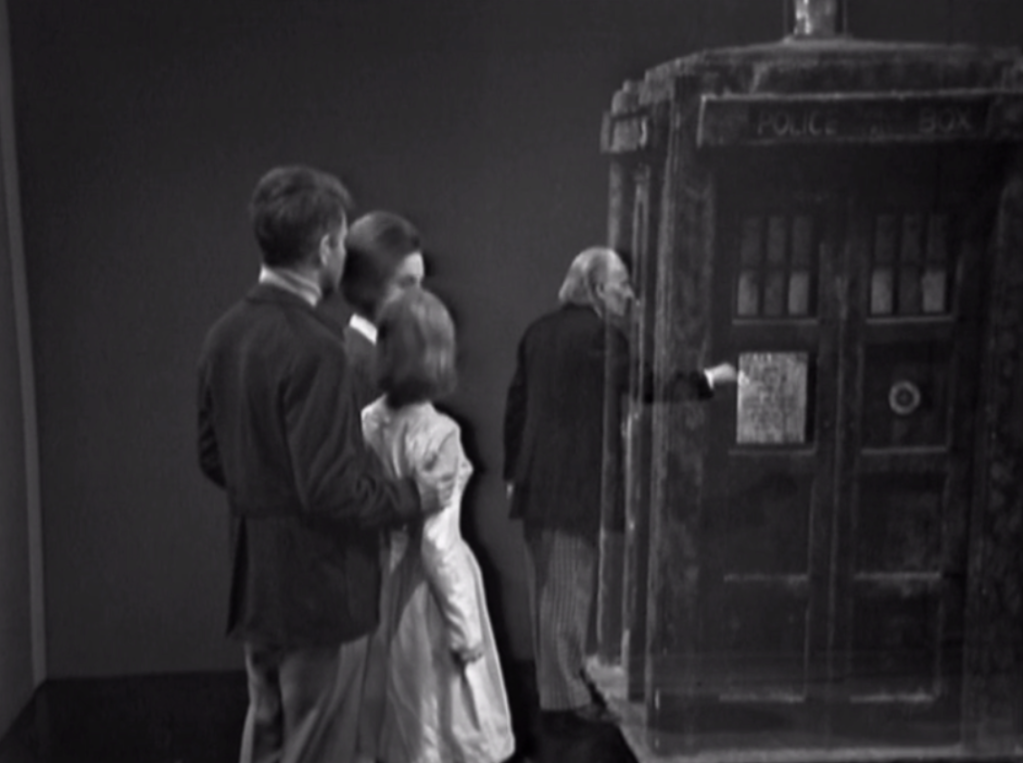
Season, Episodes 26-29 review
Four separate journeys. Four choices, that led all the time, closer to here.
Barbara on fate, The Space Museum
As a sometime science fiction writer myself, I’m well aware of the pitfalls in having a brilliant idea but struggling to turn it into a brilliant story. And so I have some sympathy for the writer of The Space Museum who clearly had a good conception with no notion as to execution: a serial with an excellent first episode that failed to live up to its early potential.
The premise of The Space Museum involves an original and complex temporal theory so it is ironic that this is not the reason the story makes little sense. It’s in its overall plotting that it falls down, not in the time loop that underpins it.

As the first episode starts, the crew are staring at the TARDIS column, transfixed. As the TARDIS materialises, they come out of their trance and their clothes have changed. Time has passed but they don’t remember it. Vicki has an incident with a glass of water where she drops and smashes it but it reassembles and bounces back into her hand. It’s clear that something very unusual has happened but what? The Doctor pretends to be unconcerned and puts their change down to ‘time and relativity’ but refuses to explain more.
They look out the view screen and see a large number of ships. The Doctor is naturally curious and says it’s a Space Museum and he wants to look around.

The planet seems dead but the atmosphere is quite liveable and even pleasant. Nonetheless they’re walking in dust but not leaving any footprints. Barbara also comments on the extraordinary silence that’s almost eerie. Also eerie is the reaction of two sentries outside a nearby building. Despite Vicki sneezing, they walk on by as though they can’t see them at all.
They go into the building the Doctor has dubbed a Space Museum and one of the first ‘exhibits’ is an old Dalek. Vicki is fascinated by the dormant pepper pot and mentions that the Dalek Invasion of Earth was 300 years before her time and she’s never seen one in person. Ian notes with some pride that they were there during that invasion but that he hopes Vicki never gets to see a real one up close. Then he pauses as he hopes that’s true (foreshadowing!).
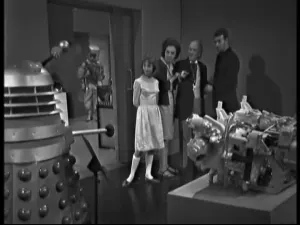

Two men come in and speak but nobody can hear them. Then Vicki touches one of the artefacts and her hand goes right through it. If this was a modern story I’d speculate they were out of phase. But the Doctor and Ian’s two options are that they’re invisible or simply not there at all.
The group search the museum for hours and find nothing but other rooms with more and more exhibits as they go deeper and deeper into the building. They finally stumble upon the TARDIS. Before they can even question how it ended up in that room when they left it outside, they realise they can’t touch it. The Doctor’s body moves through it as though it isn’t there.
As they’re finally starting to worry about what exactly is going on, they turn to find themselves inside cabinets. Museum exhibits.
How did they end up there? Or rather, how did they end up as incorporeal beings observing themselves there?
Vicki speculates that they’re stuck in a different dimension of time. Just as space has different dimensions, so does time. The TARDIS has split at some point and they are in one dimension while their other selves arrived earlier and will soon be put in the exhibits.
“It’s inexplicable,” says the Doctor.
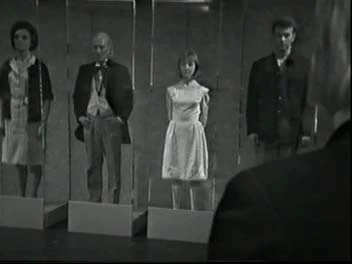
And yet strangely it’s not. In some respects I was right earlier – they are ‘out of phase’. Just not out of phase with space but out of phase with time. Essentially walking in space but observing a future time. A future in which they will end up prisoners of the museum.
The TARDIS crew now find themselves in a classic self-fulfilling prophecy dilemma. Aware of a potential future event but not the steps that led to it, like Oedipus’ father faced with the knowledge of his son’s patricide. As the group slips back into real time and the cases fade away, they know what they need to stop from happening but not how. Any step they take to avoid it may unwittingly lead them toward it.
Worse than that. Because they’e been travelling normally through space while in the wrong dimension of time, they’re already deep in the museum with no clear idea of how to extricate themselves from what seems to be inevitable. And thus the grappling with fate begins…
…or at least it should have. Faced with a need to break the chain of events that led to their imprisonment but unaware what they were, they are left with little option but to do what they would have done anyway – try to leave the museum and find the TARDIS.
Unlike other media that have tried this particular concept to varying success – Star Trek’s Time Squared for example – the TARDIS crew have only one move available to them. While the Starship Enterprise has potentially limitless options – including remaining stationary – the Doctor and his companions cannot choose to go right or left or even to stay where they are. Retracing their steps to the ship is their only possible option and so their musings about the inevitability of their fate are reduced to general grumbling about the situation.
They spend an unfortunate amount of time wandering through corridors looking lost and commenting on how they’re lost. Any step they take could lead to their eventual fate and yet they have no other path so any debate is moot and even boring. While the paralysis is philosophically interesting, the execution isn’t.
All we do is stand around saying this whole thing is a nightmare. Why don’t we do something?
Barbara, speaking for us all, The Space Museum
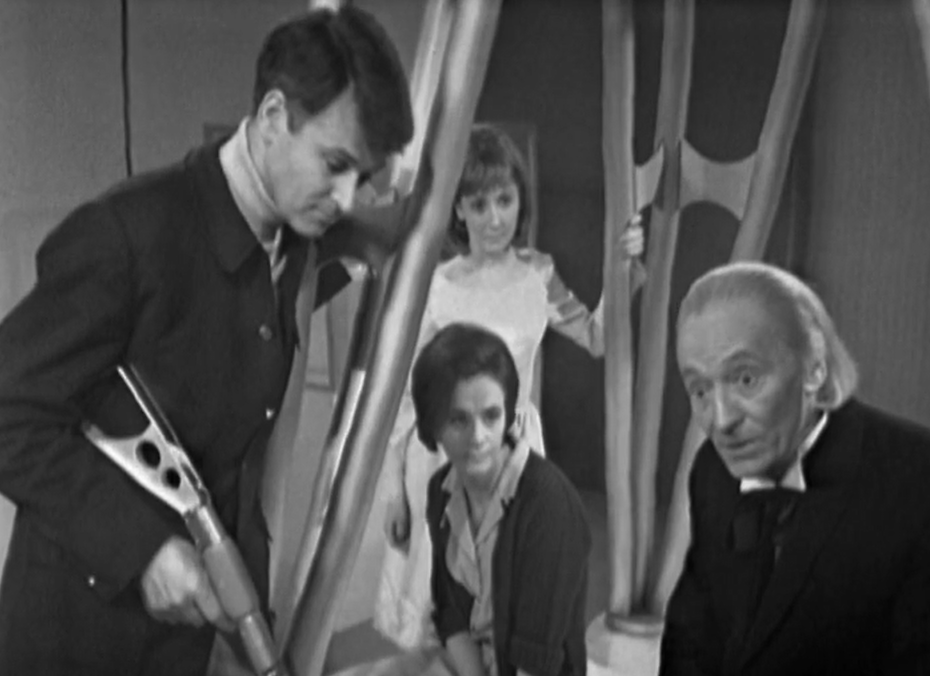
The museum as a setting is portrayed more as a labyrinth than a building for people to navigate around and, while I’ve been turned around in a museum before, this one has no signage whatsoever. As a building presumably built for visitors, its design is nonsensical. And, as we’re about to discover, their prophetic conundrum isn’t the point of the story anyway; merely a hook that sets the stakes for the real conflict.
As episode 2 opens, we switch to the world of the Space Museum itself. Thanks to what appears to be the local Governor of Exposition, we learn about the planet’s head scratching geopolitics. And… not to put too fine a point on it… it makes little sense.
The plant Xeros has been colonised by the planet Morok so they can build a giant museum that nobody ever visits. [Space Museum?! They should have called it Space Warehouse! – Eazal].
It’s staffed by enslaved Xerons for… no apparent reason I can discern. They killed all the adult Xerons and kept the children for manual labour. Now that they’re getting older, naturally a group of rebels have sprung up determined to free their planet from the clutches of disgruntled museum employees. Every single one of these people – employees, soldiers, slaves, rebels – are men. Every. Single. One.
Doctor Who’s second season has – through design or more probably coincidence – concerned itself with colonialism and resistance. Even The Web Planet could be seen as an allegory for colonialism when viewed at the right angle. However, grafting these themes onto this particular story makes it incoherent.
The Morok governor and museum curator, Lobos – a man who literally runs a building designed to display items to guests – responds to the appearance of visitors as if they are instant unqualified threats rather than, I don’t know, visitors to a museum. The Xeron rebels have an almost identical response, believing the Moroks have new allies in their fight to… clean artefacts with local labour?
Everybody knows what this planet’s used for. A museum. Well, if they came here knowing that, and they must have done, it can only be to see the Moroks.
Xeron rebel, Dako, sharing a planet-wide misapprehension on what the word ‘museum’ means, The Space Museum
Lobos orders that the visitors be detained and implies that he might want to add them to the museum. Why he wants to do either of these things is a mystery, one that will not be elucidated.
As the TARDIS crew go round and round in circles in a giant planet-sized museum with no signage (no wonder nobody visits), the Doctor gets taken by the rebels who, since the entire planet is a museum, seem to live in it and roam freely around it. There’s no real infiltration here, the rebels simply walk around the building uncontested.
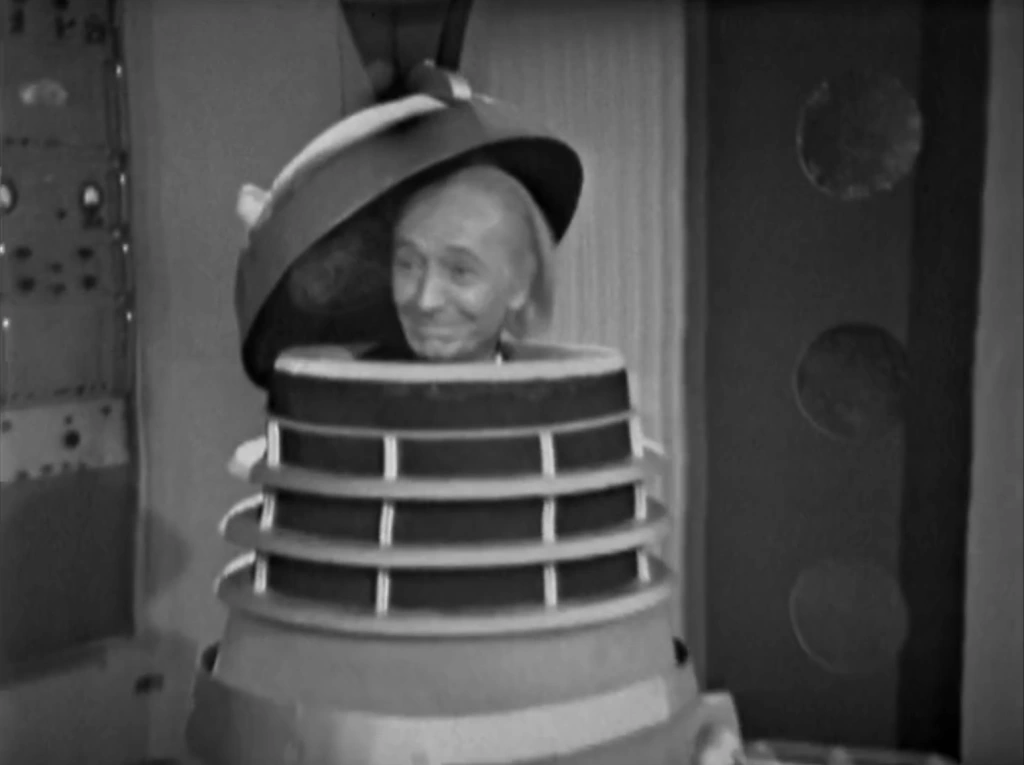
The Doctor tricks the rebels by playing dead and escapes by hiding in a Dalek. His impish grin as he appears out of the empty shell of his greatest enemy is probably the serial’s most iconic image – and hints at the comedic elements that were stripped from the script during editing.
Having escaped from the rebels, the Doctor then walks straight into some of the Morok guards and is taken to Lobos for interrogation. This is exactly what happened to me the last time I went to a museum. I was on my lunch break too so that got awkward.
Thankfully, Curator Lobo remains the Governor of Exposition so he explains the planet’s nonsensical back story, with the Space Museum “a lasting memorial to the achievements of the Morok civilisation”. He also explains why the museum receives so few visitors. The fact he detains everyone who drops by doesn’t factor into it apparently, merely their empire’s decline into comfort and stability. Nobody’s interested in the spoils of empire anymore. Also he keeps turning them into exhibits.
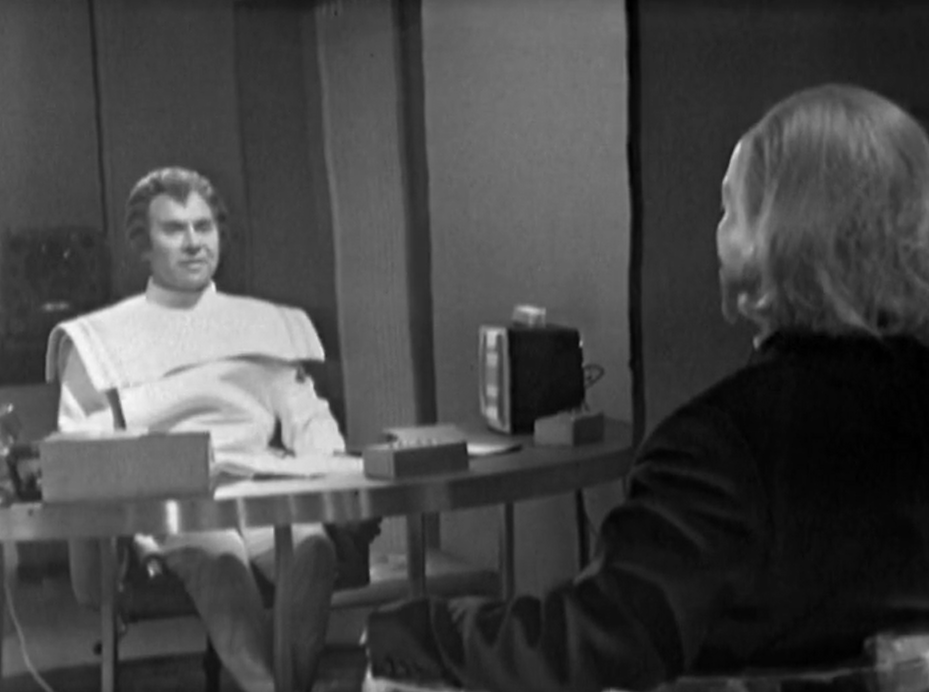
Facetiousness aside, the critique being attempted here is pretty good with the show attempting I think to examine the relationship between empire, colonial plundering and museums. But what works metaphorically doesn’t always work narratively and this is one of those times.
The Morok have a kind of telepathic interrogation whereby they pluck images from a subject’s mind and display it on a nearby television screen. This device works on the Doctor only once as he is able to control his thoughts well enough to feed false images to the machine. Lobos is enraged by this and orders him to the preparation room to be turned into a specimen for display.
I could keep asking the obvious question here, which is WHY? but from here on out the interrogative is implied.
Back in the strangely labyrinthine museum, Ian, Barbara and Vicki are stuck going round and round in circles. Ian decides to take the Theseus approach and pulls apart Barbara’s sweater so they can follow an entirely literal red thread of fate. Or rather Barbara pulls apart her own sweater because she always has to do everything around here.
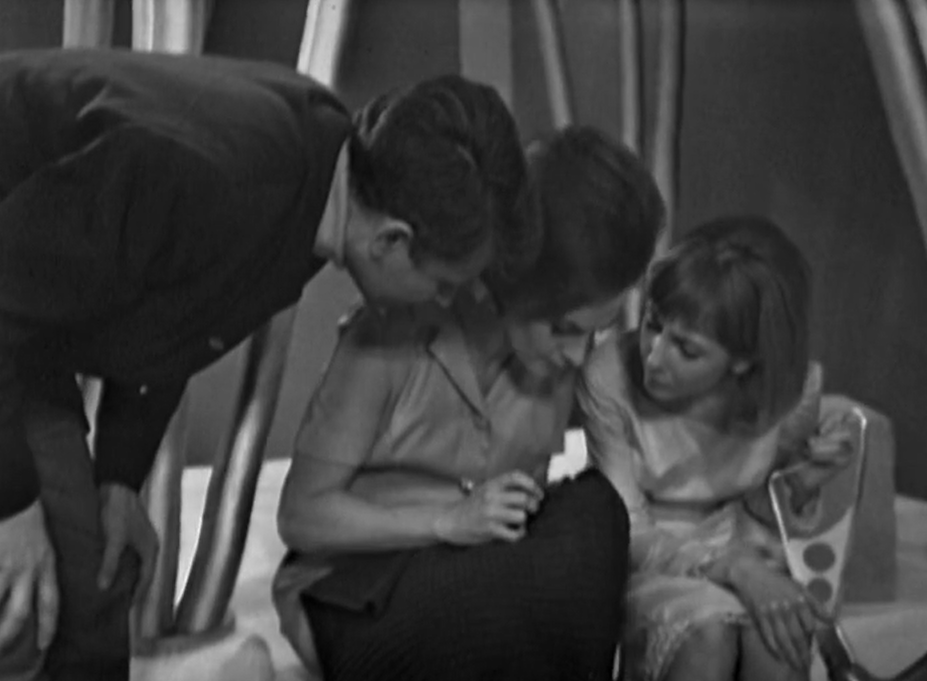
The little group manages to locate the TARDIS but their red thread also allows the rebels to follow them. Which they do. The only one they manage to grab, however, is Vicki, after an altercation with the Morok guards separates everybody. This altercation involves Ian single-handedly overpowering two heavily-armed soldiers, which is amazing even for Sir Ian’s history of fisticuffs. He forces one of them to take him to the preparation room to free the Doctor and then forces Lobos to reverse the process of embalming. He does but he and Ian are surprised by more of Lobos’ men who lock them up.
While one of the rebels heads off to find Barbara, Vicki basically incites a revolution by sheer force of will and a great deal of moxie. She comes up with a plan to rob the armoury to get weapons, hoping that if she aids the Xerons to reclaim their planet then she can avoid her own fate. She reprograms the AI lock to break into the armoury and lead the revolution. If this is where they’re heading with Vicki as a character then I won’t be complaining about her any longer. It’s true that the whole thing has an element of, well, pluckiness about it that a male character would never be given. But it’s a vast improvement on all the ankle twisting.
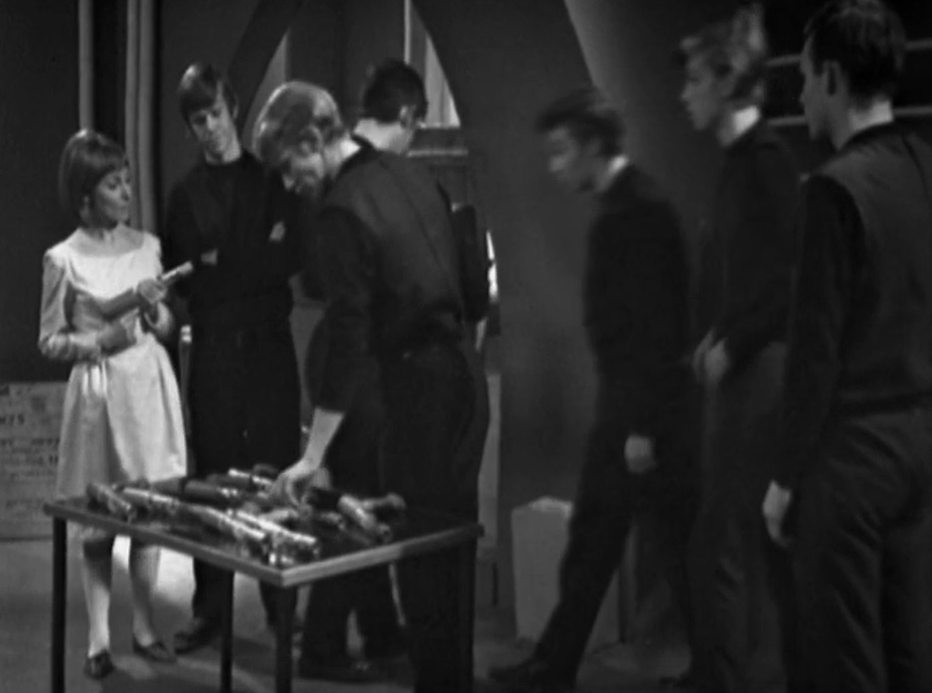
Revolution rather expeditiously underway, Vicki heads back to the museum to see if she can find her friends after a rather subtle moment between her and rebel, Tor, that speaks to a growing connection between the two. A budding romance if her rebellion hadn’t been planned and executed in about an hour.
Meanwhile, Barbara and the rebel, Dato, have been gassed by Lobos who is trying to drive the aliens out of his museum so they can be captured. Barbara manages to get Dato outside where they’re briefly detained before Vicki sweeps in and saves them. And… they’re free for about a minute before being captured again by one of Lobos’ men. Still, it means they get to where they need to go – the Governor’s office where the Doctor is imprisoned with Ian.
They have a semi-philosophical, “how did we get here, maybe this is all just fated” conversation. But of course with Vicki’s revolution happening around them they’re soon rescued by the boys. A self-defeating prophecy (this is definitely a thing, I’m sure).
The future doesn’t look too bad after all, does it?
The Doctor, on fate
The Xerons dismantle the museum and destroy all the artefacts. The Doctor and his companions can’t end up exhibits in a museum that no longer exists. History is officially changed. The locals tear down the museum and take their planet back. Which goes to show just how close this writer was to a functioning metaphor (even if it means the Doctor and his band of misfits are basically Great White Saviours).
The Doctor snaffles something called a Time and Space Visualiser that he hopes to be able to get working again.
And then they are off! Once again! Into time! And space!
But not before Vicki says a rather affectionate goodbye to Tor.

Meanwhile… out in the vastness of space… the Daleks are plotting. And they now have a time machine…

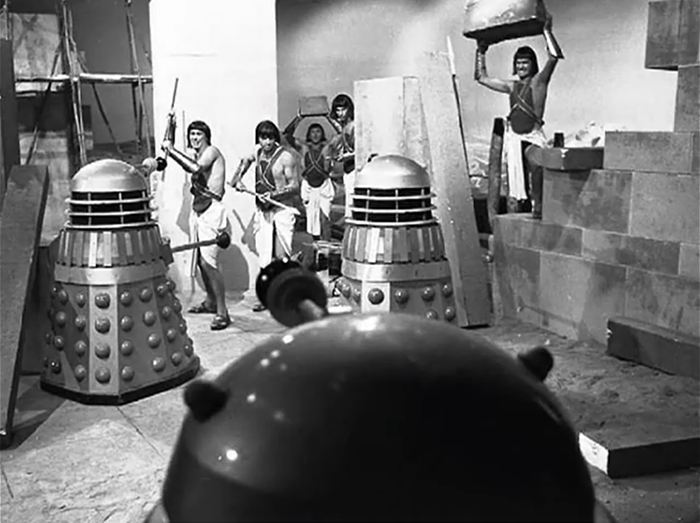
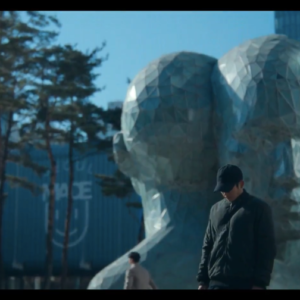

An excellent post on a story that was (is) a great concept, Lee. I guess I was also tickled pink that you have included the picture of the Doctor hiding in the Dalek, because that scene has always intrigued me and has stayed forever as part of my memories from when I first watched it when I was about four years old – probably on a repeat.
As I was double checking my viewing dates re the above (I know, why bother – but it’s a memory thing I guess), I came across Phoenix 5 (as it turns out, was the first sci-fi franchise – pipping Star Trek in this regard by many years), which I absolutely loved at that time. I was thinking about this show the other day – I have no idea why, but I couldn’t remember the name, so there you have it – Thankyou 😊